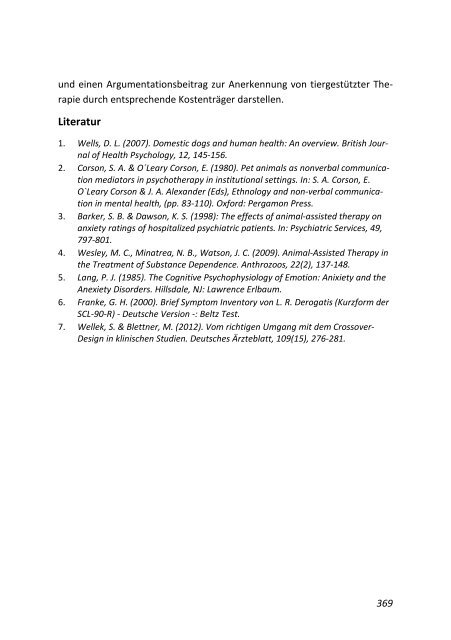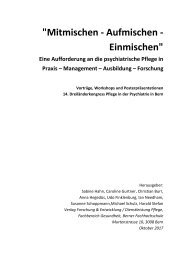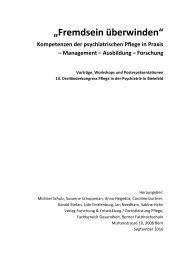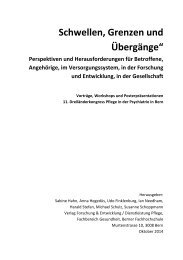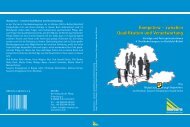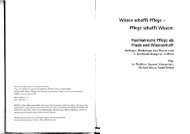- Seite 1 und 2:
„Blick zurück und nach vorn“ Z
- Seite 3:
„Blick zurück und nach vorn“.
- Seite 6 und 7:
2004 sollte, wie die folgende Aufli
- Seite 8 und 9:
Drei Orte sind es, die dem Kongress
- Seite 10 und 11:
Inhaltsverzeichnis Vorwort der Vera
- Seite 12 und 13:
20. Mitarbeiter entdecken was sie b
- Seite 14 und 15:
40. Herausfordernde Verhaltensweise
- Seite 16 und 17:
59. Welche Effekte haben verschiede
- Seite 18 und 19:
79. Ein Pflegerischer Ansatz für P
- Seite 20 und 21:
1. Prävention seelischer Gesundhei
- Seite 22 und 23:
2. Der Führerschein für seelische
- Seite 24 und 25:
Diskussion Der Führerschein für s
- Seite 26 und 27:
Methodik und Vorgehensweise Um die
- Seite 28 und 29:
4. Gestaltung der Praxisbegleitung
- Seite 30 und 31:
Arbeitsstand und erste Ergebnisse I
- Seite 32 und 33:
5. Arens, Frank/Brinker-Meyendriesc
- Seite 34 und 35:
5. Bestandsaufnahme nach drei Jahre
- Seite 36 und 37:
Auch die Hausbesuche wurden überwi
- Seite 38 und 39:
Ebenso waren die Abbruchgründe seh
- Seite 40 und 41:
6. Darstellung möglicher Auswirkun
- Seite 42 und 43:
Neben der freiwilligen Teilnahme, w
- Seite 44 und 45:
Als beteiligte Personen, welche im
- Seite 46 und 47:
7. Achtsamkeit: Ein Bezugsrahmen zu
- Seite 48 und 49:
stellt werden, dass durch den thera
- Seite 50 und 51:
tomaufklärung. Praktische Erfahrun
- Seite 52 und 53:
den Konsum von Suchtmitteln jeglich
- Seite 54 und 55:
4. Barschtipan D, (2011) „Benöti
- Seite 56 und 57:
praktische Prüfungen geben Hinweis
- Seite 58 und 59:
offenen Fragen“ und im „Anwende
- Seite 60 und 61:
Schlussfolgerungen Diese Evaluation
- Seite 62 und 63:
die Vereinbarung von Zielen und Pl
- Seite 64 und 65:
Thema Trauern ist ein tabuisierende
- Seite 66 und 67:
12. Die Gezeitengruppen - Ein Kompa
- Seite 68 und 69:
ordnet, die die Operationalisierung
- Seite 70 und 71:
Die Entdeckungsgruppe In dieser Gru
- Seite 72 und 73:
Gesundheit Neuseeland 2001, Gesundh
- Seite 74 und 75:
die Mitarbeiter im Gesundheitswesen
- Seite 76 und 77:
nung und psychiatrischer Pflege bea
- Seite 78 und 79:
Literatur Cohen, C. & Cutcliffe, J.
- Seite 80 und 81:
14. Recovery praktisch! - Die Bearb
- Seite 82 und 83:
Methodisches Vorgehen Die Gruppe tr
- Seite 84 und 85:
eigenen Fachsprache und manchmal sc
- Seite 86 und 87:
15. „Ihr werde noch lange an mich
- Seite 88 und 89:
16. Pflegerischen Interventionen de
- Seite 90 und 91:
- Screening (vorhanden sein von Sui
- Seite 92 und 93:
Pflegerische Interventionen - Konti
- Seite 94 und 95:
Schlussfolgerung Mit den oben besch
- Seite 96 und 97:
figste medizinsche Diagnose war dep
- Seite 98 und 99:
zen Theorieteil, Achtsamkeitsübung
- Seite 100 und 101:
18. Ambulante Psychiatrische Pflege
- Seite 102 und 103:
19. Pflegewissenschaft - eine Gratw
- Seite 104 und 105:
Schlussfolgerung Der Vortrag sollte
- Seite 106 und 107:
- Das Team bewertet und interpretie
- Seite 108 und 109:
21. Implementierung einer poststati
- Seite 110 und 111:
Probleme - Anspruchsvoller Caseload
- Seite 112 und 113:
stützungsangeboten, anknüpfen lä
- Seite 114 und 115:
Schlussfolgerung Die Problematik ru
- Seite 116 und 117:
produkt im Bereich der psychiatrisc
- Seite 118 und 119:
gibt einen Einblick in die Psychiat
- Seite 120 und 121:
der auf. Erfolgt eine solche Rekrea
- Seite 122 und 123:
In den 1960er Jahren begannen die s
- Seite 124 und 125:
25. Milieutherapie im stationären
- Seite 126 und 127:
Zeit und Sein - Klinikeintritte sin
- Seite 128 und 129:
zubauen und gleichzeitig Ziele der
- Seite 130 und 131:
26. Auswirkungen der EX-IN Weiterbi
- Seite 132 und 133:
Ergebnisse Insgesamt hatten 18 Pers
- Seite 134 und 135:
Einkommen bezogen die Befragten zu
- Seite 136 und 137:
27. Die Basale Expositionstherapie
- Seite 138 und 139:
tion des Patienten gegenüber exist
- Seite 140 und 141:
Behandlungsregime, die primär auf
- Seite 142 und 143:
28. Praxisempfehlung Intensivbetreu
- Seite 144 und 145:
und Auswertung vorhandener internat
- Seite 146 und 147:
022_S2_Therapeutische_Massnahmen_be
- Seite 148 und 149:
Literatur 1. Kuhn, S. & Haasen, C.
- Seite 150 und 151:
Methode Als Hauptinstrument der Eva
- Seite 152 und 153:
- Menschen die in institutionellen
- Seite 154 und 155:
32. Soziomilieugestaltung und -nutz
- Seite 156 und 157:
Ziel und Gestaltung Am Beispiel ein
- Seite 158 und 159:
Fragestellung Ziel der Qualifikatio
- Seite 160 und 161:
34. Gemeinsam in die Zukunft schrei
- Seite 162 und 163:
nen zu initiieren und Möglichkeite
- Seite 164 und 165:
Vorgehen In einem Pilotprojekt mit
- Seite 166 und 167:
36. Recovery - Paradigmenwechsel, I
- Seite 168 und 169:
- Die Altersstruktur bei den Patien
- Seite 170 und 171:
- ein theoretisches Modell: „Reco
- Seite 172 und 173:
37. Non-Suizidverträge - Eine wirk
- Seite 174 und 175:
Autor Design Hauptergebnisse Puskar
- Seite 176 und 177:
Literatur 1. Drye, R.C., Goulding,
- Seite 178 und 179:
38. Certified Peer Specialist in Ma
- Seite 180 und 181:
ingen, um angemessene Unterstützun
- Seite 182 und 183:
erforderlich die Ressource dieser B
- Seite 184 und 185:
Fragestellung Welches Kompetenz- un
- Seite 186 und 187:
Bei der Sozialen Externalität wurd
- Seite 188 und 189:
überzeugt, selbst über wichtige E
- Seite 190 und 191:
Ziel Ausgehend von der aktuellen Si
- Seite 192 und 193:
41. Deutsche Übersetzung der Suici
- Seite 194 und 195:
Diskussion / Schlussfolgerungen Mit
- Seite 196 und 197:
Sie werden kodiert und einmal jähr
- Seite 198 und 199:
aum Juli bis Dezember 2010 nicht al
- Seite 200 und 201:
43. „Offene Tür auf einer Akutst
- Seite 202 und 203:
Ein verlässlicher, verantwortungsv
- Seite 204 und 205:
treuer, Suchtberater, Familienhilfe
- Seite 206 und 207:
44. Skill und Grademix in der Akutp
- Seite 208 und 209:
den Ergebnissen, wurde dann der ers
- Seite 210 und 211:
heit über die Kompetenz wäre, ben
- Seite 212 und 213:
45. Welchen Stellenwert hat Angehö
- Seite 214 und 215:
Hinzu kommt oft Hilflosigkeit oder
- Seite 216 und 217:
Diskussion und Schlussfolgerungen E
- Seite 218 und 219:
Methode und Material Es wurde eine
- Seite 220 und 221:
Schlussfolgerungen Intensivbetreuun
- Seite 222 und 223:
47. Erfahrungen mit den Schulungsun
- Seite 224 und 225:
Es bleibt die Frage, ob der Einsatz
- Seite 226 und 227:
In der Diskussion werden die Entwic
- Seite 228 und 229:
Diskussion Die Thematik der Inklusi
- Seite 230 und 231:
49. Teilhabe durch Selbsthilfe: ein
- Seite 232 und 233:
50. „ Warum sollten wir heute die
- Seite 234 und 235:
Auch die Mitarbeiter mussten das Ge
- Seite 236 und 237:
- Motivationsarbeit - Individuelle
- Seite 238 und 239:
Diskussion Diese radikale Veränder
- Seite 240 und 241:
Welche Voraussetzungen musste meine
- Seite 242 und 243:
sion in der Gerontopsychiatrie wurd
- Seite 244 und 245:
Beschreibung der Aggressionsstufen
- Seite 246 und 247:
Aggression. Denn erst ab einem Wert
- Seite 248 und 249:
allem ein eigenes Risikoverständni
- Seite 250 und 251:
Im Anschluss an das Risikoverzeichn
- Seite 252 und 253:
Literatur 1. Klie, Thomas/Pfundstei
- Seite 254 und 255:
54. Die Totale Institution Pflegehe
- Seite 256 und 257:
mans Untersuchungsgegenstand positi
- Seite 258 und 259:
legt, um eine Gleichbehandlung für
- Seite 260 und 261:
Fragestellung Gibt es eine Wechselw
- Seite 262 und 263:
Die Aussagen der befragten Bewohner
- Seite 264 und 265:
Aber die Entscheidung, ob und welch
- Seite 266 und 267:
vollziehen konnten. Bei den organis
- Seite 268 und 269:
Ergebnisse Die Studie befindet sich
- Seite 270 und 271:
ten Bewohner (ABW) verfügtem im gr
- Seite 272 und 273:
Diskussion und Schlussfolgerungen E
- Seite 274 und 275:
Ergebnisse und Diskussion Begriffsk
- Seite 276 und 277:
Auch als längerfristige Folge kann
- Seite 278 und 279:
Auch Smith Hatcher et al. [14] leit
- Seite 280 und 281:
61. Das Unmögliche möglich machen
- Seite 282 und 283:
Gestaltung Zu Beginn wird ein kurze
- Seite 284 und 285:
Länge Die ausgewählten Texte soll
- Seite 286 und 287:
Darstellung Wenn mehrere Vortragend
- Seite 288 und 289:
Nachdem alle Anwesenden einen Platz
- Seite 290 und 291:
Ziele Nachweislich wirksame Behandl
- Seite 292 und 293:
64. Postoperatives Delirium bei äl
- Seite 294 und 295:
Material und Methode 2-Jahres-Studi
- Seite 296 und 297:
An dieser Stelle ist eine wesentlic
- Seite 298 und 299:
65. „… Gut, dass Sie bei mir ge
- Seite 300 und 301:
Pflegerische Interventionen Die Gru
- Seite 302 und 303:
An jedem Tag gab es Kurz-Kontakte u
- Seite 304 und 305:
66. „Das Fussballspielen lernt ma
- Seite 306 und 307:
entsteht. Helen Glover beschreibt,
- Seite 308 und 309:
Ergebnisse/Erfahrungen Erste Befrag
- Seite 310 und 311:
sein kann, beginnt man zu entdecken
- Seite 312 und 313:
Bezugspersonen zu haben [3]. Im All
- Seite 314 und 315:
Patienten, auf Basis psychoedukativ
- Seite 316 und 317:
16. Gros, D.F., et al., Behavioral
- Seite 318 und 319: matter-Bagnoud, Junod [5] würden s
- Seite 320 und 321: phrenen Formenkreis (z.B.Schizophre
- Seite 322 und 323: 69. Riskanter Arzneimittelkonsum in
- Seite 324 und 325: 70. „Wie finde ich Hilfe in einer
- Seite 326 und 327: Literatur 1. Lieberherr, R., Marqui
- Seite 328 und 329: sam“ und „human“ sein [2]. Es
- Seite 330 und 331: (psychischen kranken Menschen) verd
- Seite 332 und 333: 72. Ethisches Handeln in der Pflege
- Seite 334 und 335: erkrankten Menschen zu beenden, ist
- Seite 336 und 337: auf die psychiatrische Unterdrücku
- Seite 338 und 339: Schlussfolgerungen Es hat sich für
- Seite 340 und 341: Fragestellung Ziel der durchgeführ
- Seite 342 und 343: Eingehen auf die Bedürfnisse des P
- Seite 344 und 345: 74. Vergangenheit verändert die Zu
- Seite 346 und 347: eich ermöglichte, um reflektiert u
- Seite 348 und 349: nen und Diskriminierungen antizipie
- Seite 350 und 351: 76. Entstehung eines einrichtungswe
- Seite 352 und 353: finden müssen. Die positiven Effek
- Seite 354 und 355: NANDA-I 2012-2014 16 neue Pflegedia
- Seite 356 und 357: 78. Deutsche Übersetzung der Suici
- Seite 358 und 359: Literatur 3. Björkdahl, A., Nyberg
- Seite 360 und 361: - Wer hat die Zeit, um diese Beobac
- Seite 362 und 363: 80. Postoperatives Delirium bei äl
- Seite 364 und 365: 81. Wege zum „demenzfreundlichen
- Seite 366 und 367: Zusammenfassung Die Anwendung nicht
- Seite 370 und 371: 83. Gesundheitsförderung „Nachta
- Seite 372 und 373: 5. Jung, B., (2004) Betriebliche Ge
- Seite 374 und 375: 374
- Seite 376 und 377: Bierwirth Vera, Dipl. Sozialpädago
- Seite 378 und 379: Grob Silvia, BSc, Spitalregion Für
- Seite 380 und 381: *Kolbe Harald Joachim, Pflegewissen
- Seite 382 und 383: *Ott Ordelheide Petra, Dipl. Pflege
- Seite 384 und 385: *Sprenger Philipp, Dipl. Pflegefach
- Seite 386 und 387: *Zuaboni Gianfranco, Dipl. Psychiat


